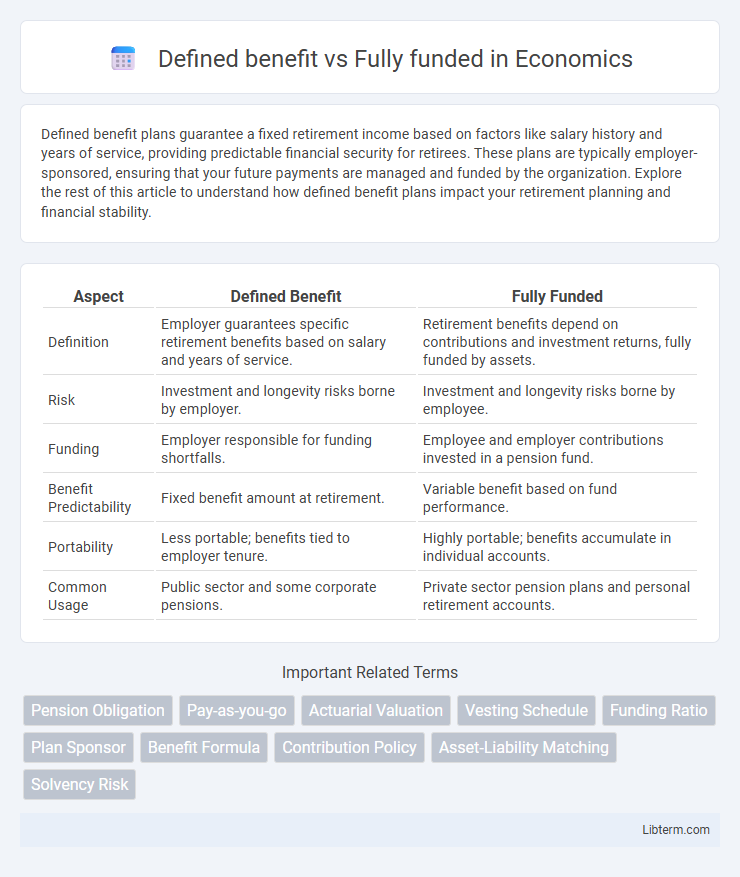Defined benefit plans guarantee a fixed retirement income based on factors like salary history and years of service, providing predictable financial security for retirees. These plans are typically employer-sponsored, ensuring that your future payments are managed and funded by the organization. Explore the rest of this article to understand how defined benefit plans impact your retirement planning and financial stability.
Table of Comparison
| Aspect | Defined Benefit | Fully Funded |
|---|---|---|
| Definition | Employer guarantees specific retirement benefits based on salary and years of service. | Retirement benefits depend on contributions and investment returns, fully funded by assets. |
| Risk | Investment and longevity risks borne by employer. | Investment and longevity risks borne by employee. |
| Funding | Employer responsible for funding shortfalls. | Employee and employer contributions invested in a pension fund. |
| Benefit Predictability | Fixed benefit amount at retirement. | Variable benefit based on fund performance. |
| Portability | Less portable; benefits tied to employer tenure. | Highly portable; benefits accumulate in individual accounts. |
| Common Usage | Public sector and some corporate pensions. | Private sector pension plans and personal retirement accounts. |
Introduction to Defined Benefit and Fully Funded Plans
Defined Benefit plans guarantee a specific retirement benefit based on salary and years of service, providing predictable income for beneficiaries. Fully Funded plans maintain sufficient assets to meet all future obligations, ensuring the plan's financial stability and minimizing risks for employers and participants. Both structures prioritize secure retirement income but differ in funding strategies and risk distribution.
Key Concepts: What is a Defined Benefit Plan?
A Defined Benefit Plan guarantees a specific retirement payout based on factors like salary history and years of service, ensuring predictable income for retirees. It typically involves employer-managed funds where investment risks are borne by the employer, distinguishing it from fully funded plans where contributions aim to cover future liabilities. Key features include actuarial calculations to determine funding requirements and a commitment to providing lifelong benefits regardless of market performance.
Understanding Fully Funded Pension Plans
Fully funded pension plans maintain assets sufficient to cover all projected liabilities, ensuring long-term financial stability and reducing risk for plan participants. Defined benefit plans guarantee a specified retirement benefit, with employer contributions varying based on actuarial valuations to meet future payment obligations. Understanding fully funded status is crucial for evaluating a pension plan's solvency and the security of promised retirement income.
Core Differences: Defined Benefit vs Fully Funded
Defined benefit plans guarantee a specific retirement benefit based on salary and years of service, shifting investment risk to the employer, whereas fully funded plans ensure that sufficient assets are set aside to cover all current and future liabilities, emphasizing asset adequacy. The core difference lies in risk allocation: defined benefit plans carry the funding risk for employers, while fully funded plans aim to eliminate funding shortfalls through prudent asset management. Investment performance impacts fully funded plans directly, whereas defined benefit plans rely on actuarial assumptions to determine contribution requirements.
Advantages of Defined Benefit Schemes
Defined benefit schemes offer predictable retirement income based on salary and years of service, providing financial security and stability for employees. Employers bear the investment risk, ensuring beneficiaries receive promised benefits regardless of market fluctuations. These schemes often include inflation protection and survivor benefits, enhancing long-term retirement security.
Pros and Cons of Fully Funded Pension Plans
Fully funded pension plans offer the advantage of ensuring that all future pension liabilities are covered by assets already set aside, reducing the risk of underfunding and providing greater financial security for retirees. However, these plans require significant upfront capital contributions and can limit an employer's cash flow flexibility compared to pay-as-you-go defined benefit plans. The fully funded approach also subjects the pension fund to market volatility, potentially impacting the plan's funding status and necessitating careful investment management.
Funding Strategies and Risk Management
Defined benefit plans rely on actuarial assumptions and employer contributions to ensure future pension payouts, requiring careful long-term funding strategies to manage longevity and investment risks. Fully funded plans maintain assets equal to or greater than their liabilities, emphasizing asset-liability matching and conservative investment policies to mitigate funding shortfalls. Effective risk management in both approaches involves continuous monitoring of funding status, use of hedging techniques, and adjusting contribution rates to maintain financial sustainability.
Impact on Employers and Employees
Defined benefit plans guarantee employees a specific retirement benefit based on salary and years of service, placing long-term funding and investment risk primarily on employers, which can lead to significant financial liabilities and budget volatility. Fully funded plans ensure that adequate assets are set aside to cover all promised benefits, reducing employers' risk exposure and increasing financial stability, while providing employees with more secure and predictable retirement income. Employees benefit from greater retirement security under fully funded schemes, whereas defined benefit plans may entail uncertainty if employers face funding shortfalls or insolvency.
Regulatory and Compliance Considerations
Defined benefit pension plans must comply with strict regulatory frameworks such as the Employee Retirement Income Security Act (ERISA) in the U.S., which mandates minimum funding requirements and regular actuarial valuations to ensure solvency. Fully funded plans, often subject to similar fiduciary standards, typically face robust compliance checks to verify that assets match projected liabilities, minimizing underfunding risks. Regulators enforce disclosure and reporting obligations on both types to maintain transparency and protect participants' retirement security.
Choosing the Right Retirement Plan Model
Selecting the right retirement plan model involves comparing defined benefit and fully funded plans based on stability, risk, and funding mechanisms. Defined benefit plans guarantee a fixed payout upon retirement, providing predictable income but requiring employer funding and actuarial management. Fully funded plans rely on accumulated contributions and investment returns, offering potentially higher returns with greater exposure to market risks and participant control.
Defined benefit Infographic

 libterm.com
libterm.com